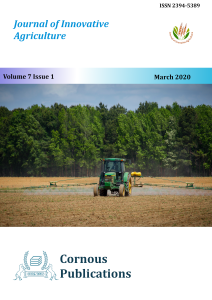
Journal of Innovative Agriculture
Peer Reviewed Open Access Journal
ISSN: 2394-5389 NAAS Rate: 4.05
Submit Manuscript
Peer Reviewed Open Access Journal
ISSN: 2394-5389 NAAS Rate: 4.05
Submit ManuscriptSix species of Eucalyptus viz., E. alba, E. camaldulensis, E. microtheca, E. tereticornis, E. polycarpa and E. torelliana, were subjected to full diallel mating. The cross between E. polycarpa and E. torelliana was characterised by post-fertilization abortion. An evaluation of the remaining four parents and 12 hybrids revealed that characters like leaf temperature and diffusive resistance were free from epistatic interaction. For the characters PAR, non-allelic interaction was obserrved. Leaf temperature was shown to be under the influence of predominantly dominant gene action. Predominance of additive gene action was evident in respect of diffusive resistance and transpiration rate. The gene distribution among the parents was observed to be unequal with greater frequencies of dominant allels for PAR and diffusive resistance. The number of genes that control the characters was one for leaf temperature, PAR and transpiration rate and two for diffusive resistance. Narrow sense heritability was low for all the attributes.
diallel mating, Eucalyptus, genetic analysis, gene action, physiological traits, tree breeding
Coughtrey, A., & Mather, K. E. N. N. E. T. H. (1970). Interaction and gene association and dispersion in diallel crosses where gene frequencies are unequal. Heredity, 25(Pt. 1), 79-88.
Hart, A. J. (1972). Tree planting in salt land areas and some recommended species and establishment practices. In The Use of Trees and Shrubs in the Dry Country of Australia (pp. 415-419). AGPS Canberra.
Hayman, B. I. (1954). The analysis of variance of diallel tables. Biometrics, 10(2), 235-244.
Hayman, B. I. (1958). The theory and analysis of diallel crosses. II. Genetics, 43(1), 63.
Jana, S. (1975). Genetic analysis by means of diallel graph. Heredity, 35(1), 1-19.
Jinks, J. (1955). A survey of the genetical basis of heterosis in a variety of diallel crosses. Heredity, 9(2), 223-238.
Jinks, J. L. (1953). Analysis of diallel crosses. Maize Genetics Cooperation Newsletter, 27, 48-54.
Jinks, J. L. (1954). The analysis of continuous variation in a diallel cross of Nicotiana rustica varieties. Genetics, 39(6), 767.
Jinks, J. L., & Mather, K. (1982). Biometrical genetics; the study of continous variation. Chapman and Hall.
Kondas, S. (1986). Pinus patula, Eucalyptus tereticornis, Bambusa arundinacea, Dendrocaalamus atrictus, Casuarina equisetifolia and Social Forestry In India. Pub: Srinivasa Industries, Sivakasi, Tamil Nadu.
Mather, K. (1967). Complementary and duplicate gene interactions in biometrical genetics. Heredity, 22(1), 97-103.
Panse, V. G., & Sukhatme, P. V. (1961). Statistical methods for agricultural workers. 2nd Edn ICAR. New Delhi, 361.
Paramathma, M., Surendran, C., & Rai, R. V. (1997). Studies on heterosis in six Eucalyptus species. Journal of Tropical Forest Science, 283-293.
Potts, B. M., & Jackson, W. D. (1986). Evolutionary processes in the Tasmanian high altitude eucalypts. In:Flora and Fauna of Alpine Australasia ages and Origins. (Ed. V.A. Barlow Pp 511-527. Csiro, Melbourne, Australia.
Potts, B. M., & Reid, J. B. (1988). Hybridization as a dispersal mechanism. Evolution, 42(6), 1245-1255.
Pryor, L. D. (1961). Inheritance, selection and breeding in Eucalyptus. Report and Documents. In Second World Forestry Conference (Vol. 1, pp. 297-304).
Pryor, L. D., & Johnson, L. A. S. (1971). A classification of the eucalypts. A classification of the Eucalypts.
Pryor, L. D., & Johnson, L. A. S. (1981). Eucalyptus, the universal Australian. Ecological biogeography of Australia, 1, 500-536.
Pryor, L.D. (1976). Biology of Eucalyptus. Arnold. London. 1.
Pryor, L.D. (1978). Reproductive habits of the Eucalyptus. Unasylva, 30 (119-120): 42-46.
Stonecypher, R. W., Zobel, B. J., & Blair, R. L. (1973). Inheritance patterns of loblolly pines from a nonselected natural population.
Turnbull, J. W. (1984). Choice of specific and seed sources. Eucalyptus for wood production, 6-65.
Zobel, B., & Talbert, J. (1984). Applied forest tree improvement. John Wiley & Sons.
